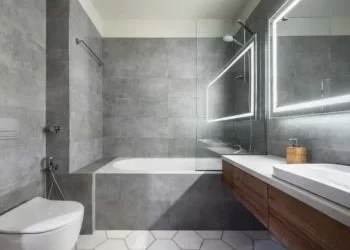The master bedroom is a sanctuary, a place of rest and rejuvenation. Within this space, the wardrobe is an essential piece of furniture. It not only stores clothing but also plays a crucial role in the room’s overall design and functionality. Master bedroom wardrobe designs have evolved over time to offer a perfect blend of elegance and practicality. This article explores the art of mastering bedroom wardrobe designs, ensuring they serve their practical purpose while enhancing the aesthetic appeal of the space.
Choosing the Right Type of Wardrobe Designs
Wardrobes come in various types, each catering to different aesthetic and functional preferences:
Built-in Wardrobes: These are customized to fit seamlessly into the bedroom space, offering a sleek and integrated look. Built-in wardrobes maximize floor-to-ceiling height and can be tailored to match the room’s decor.
Freestanding Wardrobes: These are standalone units that can be moved around the room. They offer flexibility in design and are ideal for those who prefer to change their room layout frequently.
Walk-in Closets: Larger rooms may accommodate walk-in closets, providing ample space for storage and creating a luxurious dressing area within the bedroom.

Understanding the Significance of Bedroom Wardrobes
Before delving into the specifics of wardrobe design, it’s essential to recognize the significance of this piece of furniture in the master bedroom:
Storage Solution: Bedroom wardrobes are primarily crafted to neatly store clothing and accessories, ensuring organization and tidiness in the room.
Space Efficiency: They optimize vertical space usage, particularly valuable in compact bedrooms. Well-planned wardrobe designs ensure every inch is utilized effectively.
Aesthetic Appeal: Wardrobes play a significant role in defining the room’s overall look and feel. They can either serve as a focal point or harmoniously blend with the room’s decor, depending on the chosen design.
Privacy and Organization: Wardrobes provide both privacy and organization, keeping your belongings concealed and ensuring a clutter-free bedroom conducive to relaxation.
Designing Elements for Master Bedroom Wardrobes
When aiming to master the design of bedroom wardrobes, striking a balance between elegance and functionality is crucial. Here are key design elements to consider:
Size and Layout: The dimensions and layout of the wardrobe should harmonize with those of the master bedroom. It’s crucial to ensure that the wardrobe neither dominates the space nor makes it feel cramped.
Material and Finish Selection: The material and finish chosen significantly impact the overall aesthetics. Timeless wood finishes offer a classic appeal, while mirrored surfaces can enhance the perception of space. Opting for high-quality materials and finishes ensures both elegance and durability.
Interior Organization: A well-organized interior is essential for wardrobes, featuring compartments for clothing, accessories, and other items. Strategically placed pull-out drawers, shelves, and hanging racks maximize storage efficiency.
Sliding or Hinged Doors: Choosing between sliding and hinged doors depends on available space and personal preference. Sliding doors are space-efficient, ideal for smaller bedrooms, while hinged doors offer a classic aesthetic appeal.
Lighting: Thoughtfully positioned interior lighting can enhance the functionality of the wardrobe and highlight its contents. LED lighting is particularly beneficial for its energy efficiency and versatile illumination.
Color and Style: The wardrobe’s color and style should complement the room’s decor. Neutral colors offer versatility and timelessness, while choosing between contemporary or traditional styles can align with the room’s overall theme.

Space Utilization and Organization
A well-organized wardrobe maximizes storage space and ensures easy access to your clothing and accessories. Here are some tips for optimizing space utilization and organization in your bedroom wardrobe:
Utilize Vertical Space: Maximize the wardrobe’s height with shelves and hanging racks to ensure efficient storage and organization of items.
Separate Sections: Divide the wardrobe into dedicated areas for various types of clothing. Allocate separate hanging space for dresses, shirts, and trousers, and incorporate drawers for accessories and smaller items.
Shoe Storage: Dedicate a specific section for storing shoes. Consider using shelves or pull-out trays to efficiently organize your footwear.
Drawer Dividers: Incorporate drawer dividers to maintain tidy storage of smaller items such as socks, underwear, and jewelry, ensuring they remain organized and readily accessible.
Hanging Accessories: Install hooks or hangers on the inside of wardrobe doors to hang belts, ties, scarves, and other accessories for easy access and organization.
Mirrored Wardrobe Doors
Mirrored Wardrobe Doors: Combining Style and Function
Mirrored wardrobe doors have become popular for their dual functionality. They not only provide a full-length mirror but also enhance the room’s sense of space. The reflective surface can make a small bedroom feel larger and more open, offering an elegant and practical choice that serves both aesthetic and functional purposes.
Sliding Wardrobe Doors: Maximizing Space Efficiency
Sliding wardrobe doors are an ideal choice for bedrooms with limited space. Unlike hinged doors that need clearance space to open, sliding doors glide smoothly along a track, making them perfect for smaller rooms. They provide a sleek and contemporary appearance, enhancing the overall elegance of the room.
Walk-In Wardrobes: Luxury and Functionality Combined
For those with ample space in the master bedroom, a walk-in wardrobe represents the pinnacle of luxury and functionality. Offering abundant room for organization and customization, a walk-in wardrobe may feature built-in shelving, island storage, and generous hanging space. Its design can be tailored to complement the room’s decor, seamlessly blending the bedroom with a dedicated dressing area.
Custom Closet Organizers: Tailored Storage Solutions
Custom closet organizers are growing in popularity among those looking for personalized storage solutions. Customization enables you to design a wardrobe that precisely meets your needs and complements your style. Collaborating with designers and specialists allows you to plan the layout, select materials, and incorporate specific features that cater to your lifestyle.
Eco-Friendly Wardrobe Choices: Embracing Sustainability
In line with sustainable living practices, there is increasing interest in eco-friendly wardrobe options. Incorporating sustainable materials, non-toxic finishes, and energy-efficient lighting into the design not only promotes environmental consciousness but also enhances the elegance of the master bedroom.
Conclusion
Mastering bedroom wardrobe designs involves achieving a harmonious balance between elegance and functionality. Beyond mere storage, the wardrobe serves as a design focal point that enhances the room’s aesthetic while efficiently organizing your belongings. Considerations such as size, layout, materials, and interior organization are key to creating a wardrobe that seamlessly integrates with your master bedroom’s decor. Whether opting for sliding doors, mirrored surfaces, custom designs, or eco-friendly materials, your wardrobe can become a standout feature that reflects your personal style and enriches the overall ambiance of your bedroom. Embrace the art of bedroom wardrobe design to craft a space that exudes both sophistication and practicality.







